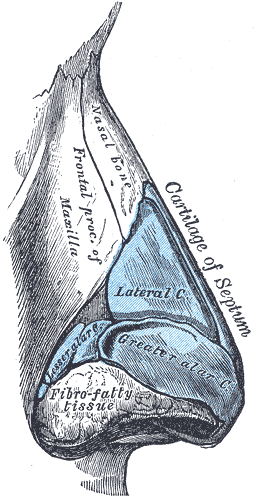Nasal cartilages
(Redirected from Nasal cartilage)
Anatomical structures of the nose
Nasal cartilages[edit | edit source]
The nasal cartilages are a group of cartilaginous structures that provide support and shape to the nose. These cartilages are essential for the structural integrity and function of the nose, playing a crucial role in both respiration and olfaction.
Anatomy[edit | edit source]
The nasal cartilages can be divided into several distinct components:
Lateral nasal cartilages[edit | edit source]
The lateral nasal cartilages are paired structures that are located on either side of the nose. They are triangular in shape and provide support to the upper part of the nose.
Greater alar cartilages[edit | edit source]
The greater alar cartilages, also known as the major alar cartilages, form the tip of the nose and the nostrils. They are responsible for the shape and contour of the nasal tip.
Lesser alar cartilages[edit | edit source]
The lesser alar cartilages are small cartilaginous structures located near the greater alar cartilages. They contribute to the shape of the nostrils.
Septal cartilage[edit | edit source]
The septal cartilage is a single, flat structure that forms the anterior part of the nasal septum. It separates the two nasal cavities and provides support to the bridge of the nose.
Function[edit | edit source]
The nasal cartilages serve several important functions:
- Structural support: They maintain the shape and structure of the nose, allowing for proper airflow and olfaction.
- Protection: The cartilages protect the underlying nasal structures from trauma.
- Flexibility: They provide flexibility to the nose, allowing it to absorb impacts and return to its original shape.
Clinical significance[edit | edit source]
The nasal cartilages are often involved in various medical conditions and surgical procedures:
Rhinoplasty[edit | edit source]
Rhinoplasty is a surgical procedure that involves the reshaping of the nasal cartilages to improve the appearance or function of the nose.
Nasal fractures[edit | edit source]
Nasal fractures can involve the nasal cartilages, leading to deformities and breathing difficulties. Treatment often requires realignment and stabilization of the cartilages.
Nasal splints[edit | edit source]
Nasal splints are used post-operatively to support the nasal cartilages and maintain the desired shape of the nose.
Related pages[edit | edit source]
Search WikiMD
Ad.Tired of being Overweight? Try W8MD's physician weight loss program.
Semaglutide (Ozempic / Wegovy and Tirzepatide (Mounjaro / Zepbound) available.
Advertise on WikiMD
|
WikiMD's Wellness Encyclopedia |
| Let Food Be Thy Medicine Medicine Thy Food - Hippocrates |
Translate this page: - East Asian
中文,
日本,
한국어,
South Asian
हिन्दी,
தமிழ்,
తెలుగు,
Urdu,
ಕನ್ನಡ,
Southeast Asian
Indonesian,
Vietnamese,
Thai,
မြန်မာဘာသာ,
বাংলা
European
español,
Deutsch,
français,
Greek,
português do Brasil,
polski,
română,
русский,
Nederlands,
norsk,
svenska,
suomi,
Italian
Middle Eastern & African
عربى,
Turkish,
Persian,
Hebrew,
Afrikaans,
isiZulu,
Kiswahili,
Other
Bulgarian,
Hungarian,
Czech,
Swedish,
മലയാളം,
मराठी,
ਪੰਜਾਬੀ,
ગુજરાતી,
Portuguese,
Ukrainian
Medical Disclaimer: WikiMD is not a substitute for professional medical advice. The information on WikiMD is provided as an information resource only, may be incorrect, outdated or misleading, and is not to be used or relied on for any diagnostic or treatment purposes. Please consult your health care provider before making any healthcare decisions or for guidance about a specific medical condition. WikiMD expressly disclaims responsibility, and shall have no liability, for any damages, loss, injury, or liability whatsoever suffered as a result of your reliance on the information contained in this site. By visiting this site you agree to the foregoing terms and conditions, which may from time to time be changed or supplemented by WikiMD. If you do not agree to the foregoing terms and conditions, you should not enter or use this site. See full disclaimer.
Credits:Most images are courtesy of Wikimedia commons, and templates, categories Wikipedia, licensed under CC BY SA or similar.
Contributors: Prab R. Tumpati, MD



